Activity
Similar Activities
Sensory Music-Making Session: Sound Story Drawing Adventure
Children’s Age: 2–2.5 years
Activity Duration: 5 – 20 minutes
A sensory music-making activity using household items to enhance sensory development and introduce children to the world of music.
Activity Duration: 5 – 20 minutes
Musical Storytelling Adventure
Children’s Age: 2–12 years
Activity Duration: 5 – 15 minutes
Let's go on a Musical Storytelling Adventure! We will read a fun storybook together and make music with shakers and drums. As we read, we can use the instruments to create sounds t…
Activity Duration: 5 – 15 minutes
Empathy Harmony: Musical Language Exchange Adventure
Children’s Age: 11–15 years
Activity Duration: 35 – 45 minutes
The "Musical Language Exchange" activity is designed for children aged 11 to 15 to explore empathy through music, instruments, and foreign languages. Participants will engage with …
Activity Duration: 35 – 45 minutes
Enchanted Digital Storytelling Adventure through Nature's Wonders
Children’s Age: 5–18 years
Activity Duration: 50 minutes
Let's go on a "Digital Storytelling Adventure"! We'll create exciting stories using nature-themed digital images and fun drawing tools on a tablet or computer. Get ready to brainst…
Activity Duration: 50 minutes
Enchanted Garden: Nature Sculpture Garden Adventure
Children’s Age: 4–6 years
Activity Duration: 10 – 25 minutes
Engage children aged 48 to 72 months in the "Nature Sculpture Garden" activity, promoting creativity and empathy. Using natural materials like sticks and leaves, along with clay an…
Activity Duration: 10 – 25 minutes
Imaginary Adventures: Mini Bowling Feelings Story Game
Children’s Age: 2–5 years
Activity Duration: 10 minutes
An engaging activity promoting sensory development, creativity, reading, and storytelling.
Activity Duration: 10 minutes
Nature Shapes Adventure: Bird Watch & Scavenger Hunt
Children’s Age: 4–5 years
Activity Duration: 10 minutes
An outdoor activity for children aged 4-5 years combining bird watching and shape recognition.
Activity Duration: 10 minutes
Musical Painting Fun: Expressive Art and Melodies
Children’s Age: 2–3 years
Activity Duration: 10 – 30 minutes
This activity involves children creating paintings while listening to music that matches the mood of sentences they choose. It helps with sensory development, and social-emotional …
Activity Duration: 10 – 30 minutes
Magical Math Journey: Sensory Math Storytime Adventure
Children’s Age: 2–3 years
Activity Duration: 10 – 30 minutes
Let's embark on the "Sensory Math Storytime" adventure! This activity blends sensory exploration, storytelling, and basic math to make learning engaging for children. You'll need t…
Activity Duration: 10 – 30 minutes
Enchanted Textures: Sensory Treasure Hunt Adventure
Children’s Age: 0 month – 6 years
Activity Duration: 5 – 10 minutes
Let's go on a Sensory Treasure Hunt adventure! We will explore different textures using our sense of touch. Gather textured items, hide them around the room, and guide the child to…
Activity Duration: 5 – 10 minutes
Nature-Inspired Drawing Activity
Children’s Age: 8–9 years
Activity Duration: 10 – 25 minutes
An outdoor activity where children draw natural elements to foster creativity and ecological awareness.
Activity Duration: 10 – 25 minutes





























